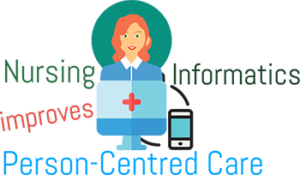Can Nursing Informatics Improve Person-Centred Care?
Trends and Issues in Nursing Informatics Column
By Melanie Neumeier RN MN
Melanie Neumeier is an Assistant Professor in the BScN Program at MacEwan University in Edmonton, AB. Her research interests include integrating new technologies into nursing education and interdisciplinary collaboration in enhancing evidence-informed nursing practice. Melanie first became interested in nursing informatics through a nursing informatics course she took in her MN program at Memorial University in Newfoundland, and has since continued that interest in her research, her writing, and her teaching.
COLUMN
 This November I had the opportunity to attend the CLPNA’s International Think Tank: Innovations in Person-Centred Care. Speakers from all over the world shared their stories and their struggles of working in health care systems that can’t quite seem to keep the person and family at the center of their own care. Personnel issues, system issues, financial issues, and policy issues were all discussed, but the one thing that almost every speaker came back to was that care recipients and care providers needed better access to more appropriate information in a more timely fashion in order to improve care. In fact the mantra that was being repeated was that in order for people to get the right care in the right place at the right time by the right provider we need the right information. This places information and information technologies right at the heart of person-centered care. Care recipients and providers need quick access to quality, personalized information, but the nature of the information needed and the way it is communicated could take a variety of forms.
This November I had the opportunity to attend the CLPNA’s International Think Tank: Innovations in Person-Centred Care. Speakers from all over the world shared their stories and their struggles of working in health care systems that can’t quite seem to keep the person and family at the center of their own care. Personnel issues, system issues, financial issues, and policy issues were all discussed, but the one thing that almost every speaker came back to was that care recipients and care providers needed better access to more appropriate information in a more timely fashion in order to improve care. In fact the mantra that was being repeated was that in order for people to get the right care in the right place at the right time by the right provider we need the right information. This places information and information technologies right at the heart of person-centered care. Care recipients and providers need quick access to quality, personalized information, but the nature of the information needed and the way it is communicated could take a variety of forms.
One communication technology that has the potential to promote person-centred care is the electronic health record (EHR) (Snyder et al., 2011). The EHR allows for multiple members of the health care team to access, update, and share critical information so that it can be used at the point of care without time delay. Ideally the data within our eHealth ecosystems could be harmonized so that no matter what door you use to enter the health care system, your information would be there. This would facilitate informed decision making without the delay of data retrieval and transfer. However, facilitating provider access to patient information is not the only potential of the EHR. Snyder et al. (2011) suggest that there are opportunities to integrate the EHR more fully as an enabler of person-centred care by using it as a communication tool with care recipients as well as providers. They suggest that the key to harnessing the potential of informatics to promote person-centred care is using appropriate technologies not only to improve access to information but to improve the communication of that information with patients and providers.
One approach that highlights this patient/provider collaboration to enhance person-centred care is a participatory care record. The participatory care record is a novel approach to electronic patient records that not only stores relevant data, but uses a dynamic display system to ensure that the salient aspects of the person’s history, their beliefs and preferences, important details of their lives and patterns of response remain visible at the point of care and not buried in hundreds of pages of text (AMIA, 2013). A participatory care record moves the medical record from a static history where important details are easily lost to a key communication bridge that can facilitate personalized care, especially when people are unable to speak for themselves (AMIA, 2013).
Information technology can also promote person-centred care through the use of personal health records (PHR) and other health enabling technologies. Personal health records allow potential care recipients to document critical information about themselves and share it with their providers (Snyder et al., 2011). Web portals can enhance communication with providers for outpatients, potentially allowing for prescription refills, booking appointments, and access to their health records and diagnostic results (Snyder et al., 2011). Wearable health technologies and health monitoring apps are becoming increasingly popular as people want to take more control over their health. Patients and providers want collaborative relationships that support health and self-management. Health care is becoming less provider-centric and new technologies can support that transition. However, no matter what technologies are used, the function of informatics in empowering person-centred care is to remove barriers by increasing access and control of information for both patients and providers (Knight & Shea, 2013).
References:
AMIA. (2013). Patient-centered care, collaboration, communication and coordination. Retrieved from: https://www.amia.org/sites/amia.org/files/2013-AMIA-Policy-Meeting-Briefing-Document.pdf
Knight, E.P., & Shea, K. (2013). A patient-focused framework integrating self-management and informatics. Journal of Nursing Scholarship, 46(2), 91–97.
Snyder, C.F., Wu, A.W., Miller, R.S., Jensen, R.E., Bantug, E.T., & Wolff, A.C. (2011). The role of informatics in promoting patient-centered care. Cancer J, 17(4): 211–218. doi:10.1097/PPO.0b013e318225ff89
Image Credit
Monitor graphic by Freepik from Flaticon is licensed under CC BY 3.0. Made with Logo Maker








